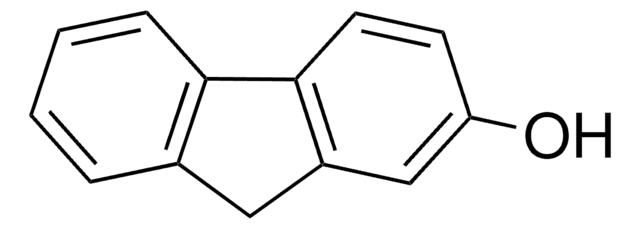361518
1-Hydroxypyrene
98%
Sinónimos:
1-Pyrenol
Iniciar sesiónpara Ver la Fijación de precios por contrato y de la organización
About This Item
Fórmula empírica (notación de Hill):
C16H10O
Número de CAS:
Peso molecular:
218.25
Número MDL:
Código UNSPSC:
12352100
ID de la sustancia en PubChem:
NACRES:
NA.22
Productos recomendados
Ensayo
98%
mp
179-182 °C (lit.)
cadena SMILES
Oc1ccc2ccc3cccc4ccc1c2c34
InChI
1S/C16H10O/c17-14-9-7-12-5-4-10-2-1-3-11-6-8-13(14)16(12)15(10)11/h1-9,17H
Clave InChI
BIJNHUAPTJVVNQ-UHFFFAOYSA-N
¿Está buscando productos similares? Visita Guía de comparación de productos
Descripción general
1-Hydroxypyrene, as a urinary metabolite, is a marker of polycyclic aromatic hydrocarbons (PAH) exposure. 1-Hydroxypyrene is an important biomarker of exposure to pyrene.
Aplicación
1-Hydroxypyrene is suitable for use in following studies:
- To investigate the fast detection and quantification of 1-hydroxypyrene in tissue extracts from Nereis diversicolor exposed to sediment-associated pyrene by a simple fluorometric method.
- To investigate the effects of genetic polymorphisms of the cytochrome P450 1A1 (CYP1A1) and 2E1 (CYP2E1) and glutathione S-transferases mu (GSTM1) and theta (GSTT1) on urinary 1-hydroxypyrene and 2-naphthol levels in aircraft maintenance workers.
- To examine the the PAH exposure of cokery workers in an Estonian oil shale processing plant.
Código de clase de almacenamiento
11 - Combustible Solids
Clase de riesgo para el agua (WGK)
WGK 3
Punto de inflamabilidad (°F)
Not applicable
Punto de inflamabilidad (°C)
Not applicable
Equipo de protección personal
dust mask type N95 (US), Eyeshields, Gloves
Elija entre una de las versiones más recientes:
¿Ya tiene este producto?
Encuentre la documentación para los productos que ha comprado recientemente en la Biblioteca de documentos.
Los clientes también vieron
Jena Webb et al.
International archives of occupational and environmental health, 91(1), 105-115 (2017-09-25)
Polycyclic aromatic hydrocarbons (PAHs) are contaminants with carcinogenic effects but little is known about their presence in environments surrounding oil drilling operations and spills or exposure levels in nearby communities. The objective of this study was to characterize PAH levels
Hueiwang Anna Jeng et al.
Journal of hazardous materials, 244-245, 436-443 (2013-01-15)
The objective of the cross-sectional study was to assess whether exposure to polycyclic aromatic hydrocarbons (PAHs) from coke oven emissions contributed to alteration of semen quality and sperm DNA integrity in nonsmoking workers. Nonsmoking coke oven workers from a steel
Christiana A Demetriou et al.
Occupational and environmental medicine, 69(9), 619-627 (2012-07-10)
The association between ambient air pollution exposure and lung cancer risk has been investigated in prospective studies and the results are generally consistent, indicating that long-term exposure to air pollution may cause lung cancer. Despite the prospective nature and consistent
Anders M B Giessing et al.
Marine environmental research, 56(5), 599-615 (2003-08-21)
The uptake of polycyclic aromatic hydrocarbons (PAHs) by marine deposit-feeding invertebrates can be determined by screening for PAH-derived metabolites. We identified 1-hydroxypyrene as the only intermediate metabolite in tissue of four species of deposit-feeding polychaetes, Nereis diversicolor, Nereis virens, Arenicola
Laura Campo et al.
International journal of environmental research and public health, 15(6) (2018-06-06)
Active smoking is associated with increased body burden of polycyclic aromatic hydrocarbons (PAHs); the aim of this study was to assess whether environmental tobacco smoking (ETS) increases the internal dose of PAHs. In 344 nonsmoking Italian adults, out of 497
Nuestro equipo de científicos tiene experiencia en todas las áreas de investigación: Ciencias de la vida, Ciencia de los materiales, Síntesis química, Cromatografía, Analítica y muchas otras.
Póngase en contacto con el Servicio técnico














